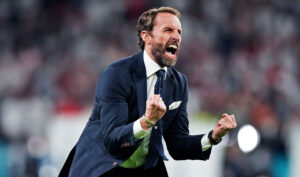A useful guide to the significance of a sporting achievement can be gleaned from how desperate politicians are to be associated with it. And given that within minutes of England’s 3-1 World Cup semi-final win over Australia on Wednesday, Lib Dem leader Ed Davey had posted a staggeringly wooden shot of himself celebrating victory in a pub, it can safely be said that England reaching the Women’s World Cup final is a very big deal indeed.
At least Davey appeared to know what was going on. Barnaby Joyce, Australia’s former deputy prime minister, posted celebratory photos after inadvertently watching an old game rather than Australia’s quarter-final win over France. But the broader point is the same: politicians in both the UK and Australia have been desperate to leap aboard the bandwagon.
In the UK, the Lionesses’ successes have been splashed across front as well as back pages. Viewing figures have been extraordinary, particularly given games are being played in the mornings: 7.2 million people watched England’s quarter-final win over Colombia (only 300,000 fewer than watched the finale of Happy Valley) and, given the final of the Euros last year drew 11.2 million, it’s safe to assume Sunday’s final against Spain will attract well over 10 million. it may even challenge the Coronation, which drew 12.03 million, as the most-watched programme of the year. What that means is far harder to say.
It is common in the wake of sporting successes to make great claims about their wider significance. Yet history isn’t always a helpful guide. Despite South Africa’s rugby union World Cup win in 1995 and footballing success at the Africa Cup of Nations the following year, it is not a happy and harmonious rainbow nation. Nor did the victory of France’s “Black-Blanc-Beur” side at the 1998 football World Cup end prejudice and racial tension there. Which is not to say that those triumphs and the celebrations that followed were worthless: symbols can still have value even if the ideal they represent remains distant, perhaps unattainable.
Jules Rimet, the French Fifa president who oversaw the birth of the men’s tournament, believed the World Cup would be a force for good, fostering greater understanding and brotherhood among nations. Even at the first World Cup, in 1930, it must have been hard to maintain that idealism as the Argentina captain Luis Monti received death threats from Uruguayan fans before the final, after which Uruguayan property in Buenos Aires was stoned and torched. By 1934 in Italy, when Mussolini took charge and turned the tournament into a celebration of fascism, it became impossible.
But then what can be expected from sport? The Olympic Games was launched in 1896 with similarly high-minded ideals; its sixth edition, scheduled for Berlin in 1916, had to be abandoned because of the First World War. Nobody, though, could realistically say, as a result, that Baron De Courbertin had failed.
So, what are major sporting events for? The expense of the London Olympics, which in retrospect can feel like a halcyon fortnight of success and national pride, was justified in part by the supposed health benefits brought by increased participation. As it turned out, participation decreased in each of the three years that followed, although there were economic benefits.
Again, it would be easy to be cynical but the context is important. The Games were awarded to London on 6 July 2005. A day later, 52 people were killed and hundreds injured in attacks on the city’s transport network by four suicide bombers. As Emeli Sandé’s rendition of “Abide With Me” at the opening ceremony made clear, the two events were linked: the Games became about defiance, about the assertion of De Coubertin’s ideals of human striving in the face of terror. Munich in 1972 and Atlanta in 1996 faced that issue far more directly.
In Australia, this World Cup has created an unprecedented buzz around football and women’s sport. The semi-final was the most watched TV event in Australian history, surpassing Cathy Freeman’s 400m gold medal at the Sydney Olympics in 2000. Yet the example of Freeman shows how fragile the supposed lessons of sport can be. At the time, it was claimed that Freeman’s success heralded a new, more inclusive Australia, yet just a year later the Australian government turned away the Tampa, a Norwegian freighter laden with asylum seekers it had rescued from the seas north of Christmas Island.
This year, nobody is making any grandiose claims about the broader significance of England’s progress to the final. Attempts to draw sweeping lessons from the fact that England are thriving under Sarina Wiegman when they struggled under Phil Neville are probably best avoided, unless the lesson is simply never to appoint Phil Neville.
Sport, after all, rarely offers straightforward messages. Consider England men’s success in the 1966 World Cup. After the various embarrassments of the Fifties, it was a reassertion of English supremacy, the mother of the game striking back. But what did that mean? The greatest of those embarrassments had come at Wembley in November 1953 with a 6-3 defeat to Hungary, the first time England had ever lost at home to non-British or Irish opposition. The symbolism of that result seemed obvious: dynamic, modern, socialist Hungary upsetting moribund old imperial England at what was then still called the Empire Stadium. It was a footballing precursor of Suez — even if, as British troops landed in Egypt in October 1956, Hungary was rising up against its Communist leaders; the narrative of British decline was far more solid than that of the Hungarian future.
The wider context of 1966, however, was not the return of imperial might but of Britain — or at least England — embracing the new reality and undergoing reinvention as a home of a vibrant and irreverent youth culture. Alf Ramsey may have been a (very) unlikely leader of it, but his England side, captained by the ineffably cool Bobby Moore, became part of swinging London. That mood was embodied in the tournament mascot, World Cup Willie, a lion with a Beatle haircut in a Union flag jersey, which chimed with the use of the flag and roundel in pop art and by bands such as The Who. The imperial lion had been transformed into something cheeky and welcoming, but it was also a commercial ploy, the first time a World Cup had thought to devise a mascot whose image could transform T-shirts and tea-towels into saleable souvenirs.
While there was certainly celebration in 1966 — it was, an AA spokesman said, “like VE Night, election night and New Year’s Eve rolled into one” — the sense is of something more contained. In the week after the final, newspaper follow-ups tended to consist of apologies from writers who had doubted Ramsey and reflections on what success might mean for the popularity of English domestic football. Nobody was talking then about a post-imperial nation rediscovering its roar, but with an ironic edge.
“Sunny Afternoon” by the Kinks was displaced at number one in the charts on the Saturday of the quarter-final but, as Dominic Sandbrook notes in White Heat, it captured the general mood: the weather was good, wages were up, and, with Britain feted for everything from James Bond to Mary Quant, David Hockney to David Bailey, The Beatles to The Rolling Stones, the World Cup win was confirmation of the self-confidence of the age. Thirty years later, England men’s progress to the semi-final of Euro 96 felt similarly linked to a blossoming of British culture, to Blur and Oasis, Damien Hirst and Danny Boyle — who, of course, would shape much of the narrative around London 2012 by directing the opening ceremony. Even Bond had emerged from a six-year hiatus with the release of Goldeneye eight months earlier.
It is different when you’re not hosting, of course, but this World Cup hasn’t felt part of a cultural moment, even if it has been far more mainstream and of a far higher standard than any previous women’s tournament. Quite rightly, there are concerns about the disparity in funding in the women’s game in different regions, but none of the debutants have looked out of their depth; there have been no thrashings like the 13-0 defeat Thailand suffered against the USA four years ago.
Quality of football is one thing, but what makes a tournament is moments and narrative, and this is a World Cup that has had both in abundance: the Lauren James stamp, the Sam Kerr equaliser, the doomed beauty of Japan’s play, the early exits of Germany and Brazil, Megan Rapinoe’s missed penalty against Sweden, Linda Caicedo recovering from cancer to score against Germany, Thembi Kgatlana’s late winner for South Africa against Italy, Spain’s progress despite the mutiny against their coach, Ella Toone’s thunderous finish…
England, in particular, has been provided with a new clutch of role models, from the buccaneering Lucy Bronze to the rapid Lauren Hemp to the scheming Keira Walsh. Available again after suspension for her red card against Nigeria, there could yet be a redemption tale for Lauren James. At the heart of it all has been Wiegman, who has reached her fourth final in her fourth major tournament. Commanding and undemonstrative, she was able to field the same starting XI in every game in leading England to the Euros last summer; this time, with injury ruling out three key players, she has had to be far more flexible and the result has been football that, while less expansive, has probably been all the more impressive. (Although, of course, it is indicative of the advantages England enjoy over other nations in terms of funding that they could afford to appoint the Dutch coach).
But perhaps the specifics matter less than the fact that England are playing well in a tournament that palpably matters. Success at the Euros did raise participation, with 32% of girls now playing football at break-time at school compared to 22% before that tournament. Women’s Super League attendances also rose dramatically last season and will presumably keep going up, increasing revenue and opportunity.
Whether this is part of some wider cultural movement, whether that matters and how long any impact lasts, it is almost certainly too early to tell. But this is undoubtedly very good news for women’s football in England. As to how good, perhaps the best guide would be to ask Davey or Joyce what they made of a game in a year or two.
Disclaimer
Some of the posts we share are controversial and we do not necessarily agree with them in the whole extend. Sometimes we agree with the content or part of it but we do not agree with the narration or language. Nevertheless we find them somehow interesting, valuable and/or informative or we share them, because we strongly believe in freedom of speech, free press and journalism. We strongly encourage you to have a critical approach to all the content, do your own research and analysis to build your own opinion.
We would be glad to have your feedback.
Source: UnHerd Read the original article here: https://unherd.com/



